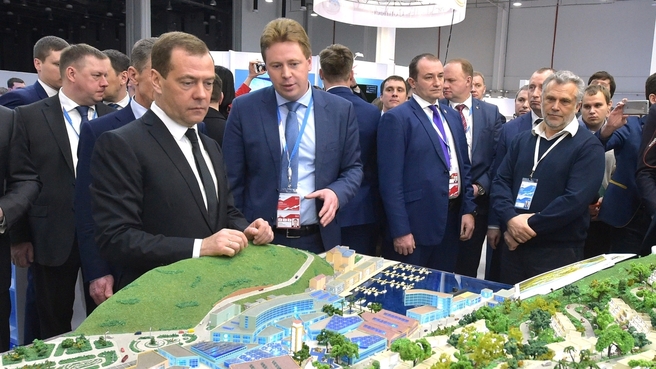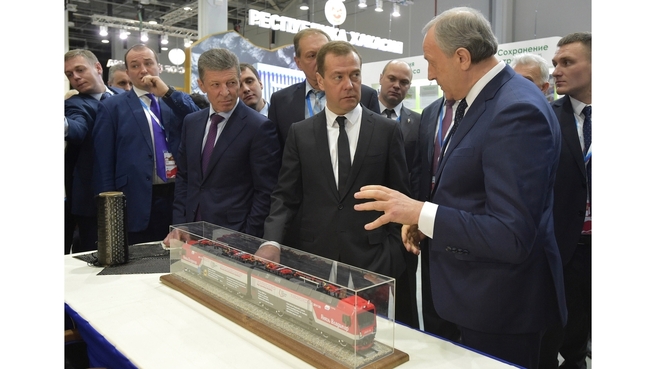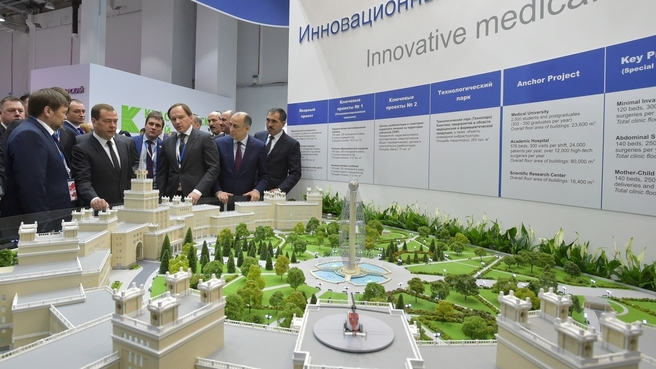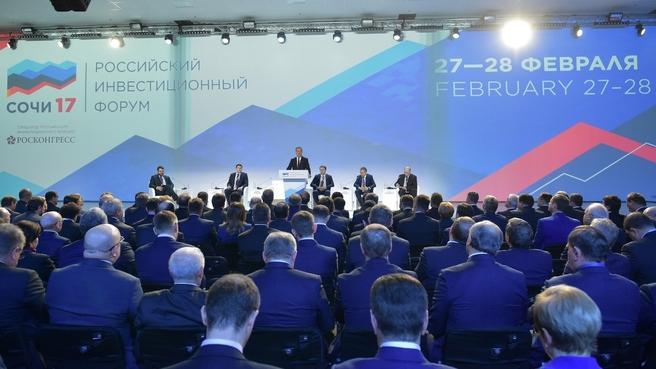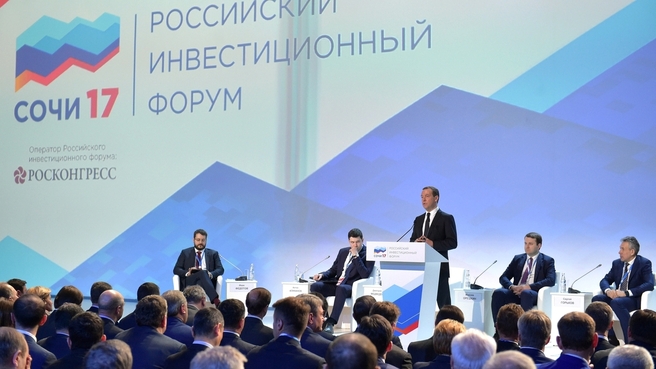The focus of the forum is investment in Russian regions as a regional policy priority.
Plenary session
Excerpt from the transcript:
Touring the exhibition stands of the Russian Investment Forum Sochi 2017
Dmitry Medvedev: We are still discussing the answers to the challenges facing Russia. Over the past few years, they were one way or another related to overcoming the crisis caused by global economic problems, volatility of commodity markets, structural imbalances in our economy, and, of course, sanctions caused by our political stance.
We learned to cope with all these challenges. The decline in GDP was halted.
The January statistics showed real disposable income entering the black and up about
8 percent on 2016. This is one of the most important results of the current
economic period.
We have all-time low inflation for modern Russia, standing at about 5.4 percent
in 2016 and 5 percent in January 2017. In late 2015, inflation was nearly 13
percent. Plans to bring inflation down to 4 percent per year are absolutely
realistic.
The situation on the labour market is stable. We have coped with unemployment. Industrial
output is modest at about 1 percent as of late 2016, although these figures are
largely in line with median figures for Europe.
There are industries showing
significantly better results. And it’s not just the commodity sector. We have
double-digit growth rates in the transport and the agricultural equipment industries
and some segments of the chemical and the pharmaceutical industries. The
agriculture (based on 4.8 percent growth) and food industries (about 2.5
percent) are growing steadily.
In general, we have stabilised the situation.
The 2017-2025 Comprehensive Action Plan of the Russian Government aims to achieve strategic goals. The key task is to develop a system of actions to achieve growth rates comparable to or even higher than the world average in the near future.
The possible priorities of the plan include Sustainable Environment, or a set of measures to ensure stability in macroeconomic dynamics and doing business, including stable tax and non-tax payments, stable rates charged by natural monopolies, stable oversight and supervisory principles, and stable government regulation and support measures. Clear rules are one of the key factors for investment decision-making both at the national and regional levels, as well as within an individual company.
The second priority is Effective Employment. This refers not to unemployment but to the lack of skilled workers. This is the result of a number of accumulated problems and the demographic gap of the 1990s. The plan includes steps that will allow the most efficient use of available human resources. In addition, we will work hard to attract skilled and talented experts to Russia.
The third priority is Smart Economy. Russia has all of the elements to become one of the world’s technology leaders. We have the intellectual capacity and resources. And most importantly, we already have the mindset of a leader – a leader that has repeatedly proved its ability to make the world’s best products.
Quite often, Russian start-ups relocate abroad because other countries offer
the most convenient environment for those capable of developing revolutionary
technologies and products. We need to establish the same efficient “ecosystem”
in our country, as well.
The new Government plan should contain additional measures to restructure the economy, to boost non-commodity exports, to implement new investment projects and to promote accelerated development of small and medium-sized businesses. In this context, I suggest that we implement a number of measures in the near term.
First, we need to create a mechanism to simplify the hedging of currency risks for Russian exporters. This involves the creation of a uniform system through which exporters would be able to obtain fixed financial revenues from export deliveries in terms of roubles.
Second, we must create competitive loan terms for foreign users of Russian products. For this purpose, the Ministry of Finance should spend part of its foreign assets on such funding.
Third, we need to create a project funding “factory” on the basis of development institutions, primarily the State Corporation Bank for Development and Foreign Economic Affairs (Vnesheconombank). Project funding should include the resources of outside investors in line with syndication principles. At the same time, the state must assume risks associated with changing interest rates. On the whole, the state could guarantee stable inflation at a certain level.
Inadequate state standards are a serious factor hampering investment activity and aggravating the business environment. I would like to ask members of the Government’s Expert Council to see what further measures can be suggested here.
The further rationalisation of the tax system is a key issue, due to be reflected in our mid-term plan. We must maintain a stable tax system and also incentivise economic activity. In other words, we must create a favourable environment that would dissuade companies from joining the shadow economy.
We will refrain from making any decisions which may worsen
the situation of entrepreneurs in terms of non-tax payments. We will also
continue to cut down on the amount of reporting required from businesses.
The social sphere is next. The money that we invest in the social sphere should
be used more effectively. Unfortunately, we are now exporting not only oil and
gas, but also intellectual resources. We must create the proper environment for
the new generation to be able to unlock their potential in Russia, so that
we can export intellectual products and services rather than intellect per se.
We must actively adopt innovative management
techniques, and actively implement project-based approaches. The next step for
us is to base a large portion of the budget process on project principles.
Changes in the budget for the next three years must be articulated as projects
with clear goals, and officials responsible for implementing them must be
appointed.
The implementation of the plan should bring about a new situation in the
economy.
It should be an economy with growth rates above the worldwide average. An
economy that is open to the future in terms of technology and institutions.
It must be an economy of opportunities so that people in any part of our
country can have access to the means of social mobility.
Our economy must not be just free, it must be smart as well.
A high level of investment activity is one of the main
components of such an economy.
The world is dominated by the economic behaviour of
saving. This is the response of economic actors and investors to overall
uncertainty. For us, it’s trillions of roubles, which could be used to grow the
economy, but lie around unused instead.
The goal of the federal and regional authorities is to make this money work.
Our first goal is to identify growth points in each area. The infrastructure
projects that are critical to the development of the region should receive
guaranteed funding.
We are currently using other tools to stimulate investment, including the
creation of advanced development territories, technology parks, industrial
parks and tourist clusters. This involves public-private partnerships where
infrastructure is built with financing partially provided from the federal
budget.
The role of regional and local authorities in creating a favourable investment
climate should increase. We need to bring aboard more investors and concentrate
public and private money in priority economic areas, which can provide the
maximum payback for a city, a region, and our entire country.
This year we increased the total amount of grants and subsidies by almost 200 billion roubles. At the same time, we expanded the regions’ ability to make decision regarding privileges and preferences. Since 2016, we have been allocating grants to the best performing regions in terms of economic growth. In 2017, 20 billion roubles will be spent for this purpose. In 2018, the regions will retain a portion of the increased revenue tax.
All key areas of our work are outlined in the State Policy Guidelines for Regional Development of the Russian Federation to 2025 developed by the Government and approved by the President. More details will be provided in the action plan for their implementation and our country’s spatial development strategy.
<…>

